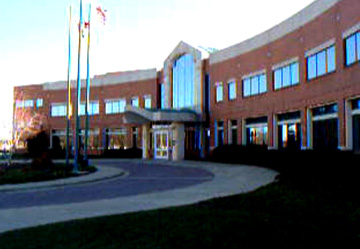

| T H E N I H C A T A L Y S T | J A N U A R Y – F E B R U A R Y 2006 |
|
|
|
A New 'Pathway to Discovery' on the NIH RoadmapIMAGING PROBE DEVELOPMENT CENTER COMING SOON |
 |
|
Good
Chemistry: Gary
Griffiths, first director of the new Imaging Probe Development Center,
NHLBI, says this NIH Roadmap generated core resource offers a "unique
and exciting opportunity" for brainstorming between chemists and
biomedical scientists
|
 |
|
The
soon-to-be-home of the IPDC
|
A new NIH core resource equipped to enable concurrent synthesis of multiple types of imaging and detection agents will open this June.
Its new director has been recruited, and the facility is taking shape to match the mission and services identified in early NIH Roadmap discussions of critical "Pathways to Discovery" initiatives.
The NHLBI-affiliated Imaging Probe Development Center (IPDC) will harness and combine the talents of chemists and biomedical scientists to produce known imaging probes that are not commercially available and to generate novel imaging probes for biomedical research and clinical applications.
It will serve the intramural community as well as extramural scientists who may be limited in their investigation of interesting probes by a lack of synthetic chemistry capabilities.
The IPDC will initially generate known imaging probes for targeting receptors, cells, and tissues and for preclinical in vivo evaluations. The center will solicit proposals from throughout the NIH scientific community for the preparation of these probes.
Although many such interesting agents have been described in the scientific literature, they are often not explored further due to lack of a reliable supply of reagent. The IPDC aims to rectify this situation.
The center will also seek to develop novel state-of-the-art imaging probes in collaboration with biological and biomedical scientists, both within NIH and extramurally, who can provide or suggest suitable targeting agent-receptor pairs.
As envisioned in the Roadmap, the IPDC will embrace and integrate under one roof three discrete advances:
![]() Exponential increases in knowledge of disease-related cellular substructures
Exponential increases in knowledge of disease-related cellular substructures
![]() An ever-growing expertise in the design of target-specific probes
An ever-growing expertise in the design of target-specific probes
![]() Contemporaneous improvements in imaging modalities
Contemporaneous improvements in imaging modalities
The result will be a new generation of imaging and detection agents that boast both rational design and optimal contrast characteristics, says Gary Griffiths, IPDC director.
Irrespective of the imaging modality
under consideration, the probes will need to exhibit high specific binding to
their targets and rapid clearance from background, resulting in high target-to-background
contrast ratios. The contrast ratio is the key characteristic of any good imaging
agent, Griffiths notes.
Optimal ratios can be achieved in several
different ways via various chemical modifications of the targeting probe either
to achieve amplified target uptake and retention of probes and/or to lower binding
to nontarget tissues or proteins.
Logistics
Once fully staffed, in late 2006, the IPDC will house 15 to 20 scientists, mainly devoted to synthetic chemistry and related support functions. The chemistry staff will have a diverse skill set that encompasses expertise in developing probes based on optical, radionuclide, MRI, and other modalities.
Initial funding for the IPDC came from each of the NIH institutes. It is anticipated that the center will become self-supporting through user fees applied on a cost-recovery basis.
The IPDC will operate under guidance
from its steering committee, which has been drawn from multiple institutes and
represents a wide range of expertise and interests across the spectrum of imaging
technologies.
The steering committee meets monthly
to discuss the progress and future directions of the IPDC and to advise the
director on administrative matters and scientific operations.
The
current members of the IPDC steering committee and their institutional affiliations
are Christopher Austin (NHGRI),
Robert Balaban (NHLBI), Allen
Braun (NIDCD), Martin
Brechbiel (NCI/NIAID), Henry
Bryant (CC/DRD), Peter
Choyke (NCI), Amir
Gandjbakhche (NICHD), Daniel
Hommer (NIAAA), Robert
Innis (NIMH), Peter
Jahrling (NIAID), Yong
Sok Lee (CIT), King
Li (CC/DRD), Roderic
Pettigrew (NIBIB), Kenner
Rice (NIDDK/NIDA), James
Sellers (NHLBI), Richard
Siegel (NIAMS), and Afonso
Silva (NINDS). ![]()
With more than 25 years experience in synthetic chemistry, much of it related to biological imaging and the application of chemistry to biological systems within interdisciplinary environments, Gary Griffiths expects to feel comfortably at home at the Imaging Probe Development Center. He's on board now at NHLBI as the first director of the IPDC and preparing for the opening of facilities in June. Griffiths' most recent research relates to targeted approaches to cancer diagnosis and therapy. He has designed, prepared, and tested numerous monoclonal antibody conjugates of chemotherapeutic drugs, polymers, enzymes, toxins, and radionuclides and has developed several agents for human clinical trials. Griffiths has also worked extensively on binary targeting systems involving bispecific antibodies and low- molecular-weight diagnostic and therapeutic agents. Designed for high in vivo target-specific uptake coupled with rapid background tissue clearance, binary targeting systems achieve the high target-to-background needed for high therapeutic indices and high-contrast diagnostics. They offer flexibility in synthetic design of the imaging or therapy agent. Along with an extensive bibiography,
Griffiths has a patent portfolio that includes 35 U.S. patents, a similar
number of foreign counterparts, and additional patent applications in
progress. |